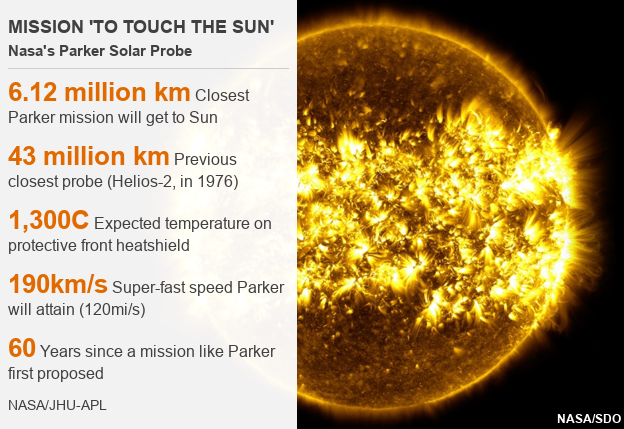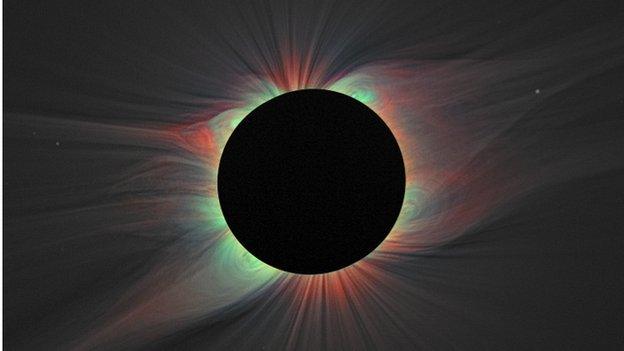Parker Solar Probe: Nasa mission to unlock Sun's mysteries delayed
- Published
Parker Solar Probe: How Nasa is trying to 'touch' the Sun
A US space agency Nasa mission to send a satellite closer to the Sun than any before has been stood down.
The Parker Solar Probe was set to launch from Cape Canaveral, Florida, on Saturday, but last-minute investigations have delayed it for 24 hours.
It is now scheduled to blast off - on board the mammoth Delta-IV Heavy rocket - on Sunday morning.
The probe is set to become the fastest-moving manmade object in history.
The rocket was on the launch pad when the countdown clock was interrupted, as officials investigated an alarm.
The vehicle had a weather window of 65 minutes to launch, but the time elapsed before the issue could be resolved.
The probe aims to dip directly into our star's outer atmosphere, or corona.
Its data promises to crack longstanding mysteries about the Sun's behaviour - assuming it can survive roasting temperatures above 1,000C.


The Delta-IV Heavy rocket with the Parker Solar Probe onboard
The Delta will hurl the probe into the inner Solar System, enabling the Nasa mission to zip past Venus in six weeks and make a first rendezvous with the Sun a further six weeks after that.
Over the course of seven years, Parker will make 24 loops around our star to study the physics of the corona, the place where much of the important activity that affects the Earth seems to originate.
The probe will dip inside this tenuous atmosphere, sampling conditions, and getting to just 6.16 million km (3.83 million miles) from the Sun's broiling "surface".
"I realise that might not sound that close, but imagine the Sun and the Earth were a metre apart. Parker Solar Probe would be just 4cm away from the Sun," explained Dr Nicky Fox, the British-born project scientist who is affiliated to the Johns Hopkins Applied Physics Laboratory.
"It will also be the fastest man-made object ever, travelling at speeds of up to 430,000mph [690,000km/h] - New York to Tokyo in under a minute!" she told BBC News.
Parker scientist Dr Nicky Fox: "Never before have we gone up and literally touched our star"
Why is this mission important?
Parker will help us better understand how the Sun works.
The star is constantly bombarding the Earth with charged particles and magnetic fields. This perpetual flow, or "solar wind", is responsible for generating the beautiful auroral lights that appear in polar skies, but there are some interactions that initiate much more troubling effects.
The biggest outbursts from the Sun will rattle the Earth's magnetic field. In the process, communications may be disrupted, satellites can be knocked offline, and power grids will be vulnerable to electrical surges.
Scientists try to forecast these "storms" and Parker promises new and valuable information to help them do that.

The diffuse corona is only visible to us on Earth during a total solar eclipse
Why go so close to the Sun?
Parker wants to get where the action is.
The corona is a remarkable place. It's strangely hotter than the Sun's actual surface, or photosphere. While this can be 6,000 degrees, the outer atmosphere may reach temperatures of a few million degrees.
The mechanisms that produce this super-heating are not fully understood.

Artwork: Parker must always keep its heatshield pointed at the Sun

Likewise, the corona is the place where the solar wind gets its big kick in speed, sweeping out across the Solar System at more than 500km/s (a million mph).
Parker aims to solve these puzzles by directly sampling the corona's particle, magnetic and electric fields.
How will Parker survive?
A mission like Parker was first proposed 60 years ago, but it's only now that engineers have the technology available to keep a probe safe so close to the Sun.
Nearly everything on the spacecraft must sit behind an 11.5cm-thick (4.5in) carbon-composite sunshield. This will maintain all parts behind the barrier at a tolerable 30C.
The probe is solar-powered - obviously. But that in itself is a challenge because the solar cells will have to be moved into sunlight to work and they hate high temperatures.
So, Parker's arrays will be water-cooled, with the onboard computer system constantly adjusting their position so that only the minimum surface area absolutely necessary to generate power is exposed beyond the shield.
Autonomy is also crucial for this mission. Close to the Sun, the radio interference is intense, and Parker will be out of contact. The probe must manage any faults itself.
Above all, it has to keep the shield always pointing at the Sun to avoid being destroyed.

Parker has a high level of autonomy
What is Europe doing?
The European Space Agency has its own version of Parker.
Solar Orbiter, or SolO as it's sometimes known, is undergoing final assembly and testing in the UK. It is expected to launch in 2020, arriving at its closest position to the Sun towards the end of Parker's planned seven years of operations.
SolO will go to within 42 million km of the Sun's surface. That's further away than Parker but it will still need an impressive shield.
Being at a more distant position, though, means SolO can do things Parker cannot - like look directly at the Sun. This enables the pair to do complementary science.
"Parker Solar Probe will get close and sit in - and make measurements of - the material coming off of the Sun. Meanwhile, Solar Orbiter, from its position, will make those measurements, too, but it will also be able to take pictures and it will be able to look at where the emissions are coming from," said Prof Lucie Green, from the UCL Mullard Space Science Laboratory in the UK.

Airbus in the UK is assembling Solar Orbiter for European scientists
Jonathan.Amos-INTERNET@bbc.co.uk, external and follow me on Twitter: @BBCAmos, external